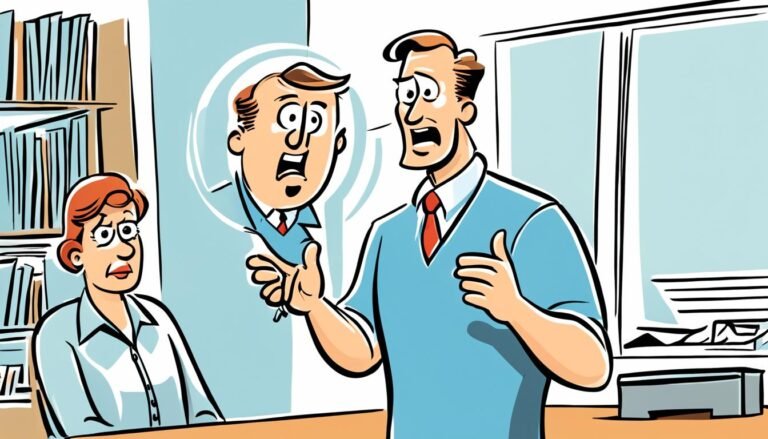Create Urgency in Sales Tactics to Boost Your Business
Creating urgency in sales is a powerful tactic that can help your business stand out in a crowded market and drive sales. By tapping into the psychology of urgency, you can motivate potential customers to make quick purchase decisions and increase conversions.
When it comes to sales, urgency plays a crucial role in capturing the attention of prospects and closing deals. By leveraging proven sales techniques and strategies, you can create a sense of urgency that compels customers to take immediate action.
Whether it’s limited-time offers, scarcity tactics, or using compelling language, the key is to create a sense of urgency that triggers the fear of missing out (FOMO) and drives customers to make a purchase decision now rather than later.
Key Takeaways:
- Create a sense of urgency to motivate customers to act quickly.
- Use limited-time offers and scarcity tactics to heighten urgency.
- Le
What Is Urgency in Sales?
Urgency in sales refers to the powerful strategy of creating a sense of urgency that motivates potential customers to make a purchase decision quickly. By leveraging psychological triggers like FOMO (fear of missing out) and scarcity, sales professionals can drive customers to take immediate action and increase conversions.
Urgency can be created through various tactics, such as:
- Limited-time offers: By setting a specific time frame for a promotional offer, businesses create a sense of urgency, compelling customers to act promptly to take advantage of the opportunity.
- Countdown timers: Displaying a countdown timer or a ticking clock can create a visual reminder of the limited time available, urging customers to take immediate action.
- Emphasizing immediate benefits: Highlighting the immediate benefits and value customers will gain by making a purchase now rather than later can enhance the sense of urgency and motivate them to buy.
- Using urgent language: Employing words and phrases like “act now,” “limited stock,” or “last chance” can trigger a sense of urgency and prompt customers to take action without delay.
By implementing these urgency-driven techniques, businesses tap into customers’ fear of missing out and create a compelling motivation to buy. This approach drives customers to take immediate action, increasing conversions and enhancing overall sales performance.
Image:
The Benefits of Creating Urgency in Sales
Creating urgency in sales offers numerous benefits for businesses. By implementing urgency tactics, businesses can effectively stand out from the competition and increase sales. Here are some key advantages:
Making Immediate Decisions:
Urgency helps customers make quick purchase decisions. When presented with limited-time offers or time-sensitive deals, customers are compelled to take immediate action, resulting in increased sales and conversions.
Building Better Relationships:
By creating urgency, businesses show their commitment to their customers’ success. This builds trust and strengthens relationships, leading to long-term loyalty and repeat business.
Making Purchasing Easier:
Urgency eliminates procrastination and reduces the likelihood of negotiations. It simplifies the purchasing process for customers, allowing them to make quick decisions without second-guessing, ultimately streamlining the sales process.
Increasing Sales:
The sense of urgency created by limited-time offers and other strategies drives customers to take immediate action, resulting in increased sales. Urgency helps businesses capture the attention of potential buyers and motivates them to make purchases without delay.
Reducing Sales Burnout:
By leveraging urgency, businesses can avoid sales burnout. Urgency tactics inject excitement and motivation into the sales process, preventing stagnation and maintaining high energy levels among sales teams.
Building a Sales Culture:
Creating urgency in sales helps build a sales culture within an organization. It fosters a sense of urgency and drive among sales professionals, encouraging them to proactively pursue opportunities and excel in their roles.
Improving Sales Strategy:
Implementing urgency in sales prompts businesses to assess and refine their sales strategies. It encourages continuous improvement, as sales professionals adapt their approaches to better align with customers’ quick decision-making mindset.
Overall, creating urgency in sales has a transformative impact on businesses. It not only enhances sales performance but also fosters better customer relationships, streamlines the purchasing process, and contributes to the development of a robust sales culture.
The Basic Sales Process
The basic sales process is a structured approach that sales professionals utilize to guide their interactions with potential clients. This process consists of several stages, each crucial for a successful sale. Understanding and effectively executing this process can significantly improve sales outcomes and increase conversion rates.
1. Prospecting
Prospecting is the first stage of the sales process, where sales professionals identify potential clients or leads. This stage involves researching and evaluating individuals or companies that match their target market. Prospecting also entails assessing their needs, budget, and potential interest in the product or service being offered. By identifying qualified leads, sales professionals can prioritize their efforts and focus on individuals or organizations most likely to convert into customers.
2. Preparation
The preparation stage is crucial for sales professionals to effectively engage with potential clients. It involves gathering essential information about the product or service, competitors, and the target market. Sales professionals need to create a personalized sales presentation that highlights the unique value propositions and benefits of their offering. Understanding the specific demands and pain points of the prospects enables sales professionals to tailor their approach and effectively address their needs.
3. Approach
During the approach stage, sales professionals make initial contact with their prospects. This stage requires employing various techniques to engage potential clients and create a favorable first impression. Sales professionals can use strategies such as the premium approach, question approach, or product approach to capture the prospects’ attention and establish rapport. A compelling and well-crafted approach sets the stage for a productive sales conversation.
4. Presentation
The presentation stage is where sales professionals demonstrate how their product or service meets the prospects’ needs. It involves showcasing the features, benefits, and value proposition of the offering in a clear and engaging manner. Sales professionals must effectively communicate the unique selling points and competitive advantages of their product or service. A persuasive presentation builds confidence in the prospects and enhances the likelihood of a successful sale.
5. Handling Objections
Handling objections is a critical stage of the sales process. Sales professionals need to attentively listen to the prospects’ concerns, questions, or doubts and address them effectively. This stage requires active listening, empathy, and the ability to provide concise and convincing responses. By addressing objections, sales professionals can alleviate any doubts or hesitations the prospects may have and move closer to closing the sale.
6. Closing
The closing stage is where the sales professional seeks a commitment from the prospect to proceed with the purchase. This stage involves using various closing techniques, such as the choice close, extra inducement close, or standing room only close. Sales professionals must identify the most effective approach for each prospect based on their communication style and preferences. A well-executed closing can result in a successful sale and customer acquisition.
7. Follow-Up
The follow-up stage is crucial for maintaining relationships with closed customers and potentially generating repeat business and referrals. Sales professionals must continue to engage with customers after the sale, ensuring their satisfaction and addressing any post-sale queries or concerns. This stage involves nurturing the customer relationship, providing ongoing support, and actively seeking opportunities for upselling or cross-selling.
The basic sales process involves a strategic and systematic approach to guide sales professionals through every step of the customer journey. By effectively prospecting, preparing, approaching, presenting, handling objections, closing deals, and following up, sales professionals can maximize their chances of success and drive business growth.
| Stage | Description |
|—————–|——————————————————————-|
| Prospecting | Identify potential clients and evaluate their needs and interest |
| Preparation | Gather essential information and create a personalized sales pitch |
| Approach | Make initial contact and establish rapport |
| Presentation | Demonstrate the product or service to address prospect’s needs |
| Handling Objections | Address any concerns or doubts expressed by the prospect |
| Closing | Seek commitment from the prospect to proceed with the purchase |
| Follow-Up | Maintain relationships with closed customers and seek referrals |
Why Is Urgency in Sales Important?
Urgency in sales plays a vital role in driving business growth and boosting sales. By implementing urgency tactics, businesses can effectively stand out from the competition and capture the attention of potential customers, compelling them to take immediate action and make a purchase. This sense of urgency benefits customers as well, helping them make quick decisions and ensuring they don’t miss out on valuable opportunities.
One of the key advantages of urgency in sales is its ability to build better relationships with customers. When businesses create urgency, they demonstrate their commitment to customers’ success, showing that they understand the importance of their immediate needs. This builds trust and strengthens the relationship, enhancing customers’ confidence in the brand and increasing the likelihood of repeat purchases.
Moreover, urgency in sales makes the purchasing process easier for customers. By eliminating procrastination and encouraging immediate action, businesses can reduce the time spent in negotiations and decision-making, streamlining the buying process. This not only saves time for both parties but also minimizes the potential for customers to reconsider their decision or shop around for other options.
Ultimately, the importance of urgency in sales lies in its ability to increase sales and maximize conversions. By instilling a sense of urgency, businesses can tap into customers’ fear of missing out, motivating them to act promptly and make a purchase. This sense of urgency drives customers towards a buying decision, increasing the chances of closing deals and generating revenue.
“The power of urgency in sales lies in its ability to create a sense of immediate need, driving customers to take action and make a purchase decision.”
Overall, incorporating urgency into sales strategies is crucial for businesses aiming to drive sales growth and achieve success in a competitive market. By leveraging the importance of urgency, businesses can effectively stand out, engage customers, and increase sales, ultimately establishing a strong foothold in their industry.
How to Create Urgency in Sales
Creating urgency in sales is a vital strategy to drive conversions and maximize sales. By implementing effective tactics, businesses can motivate customers to take immediate action and make a purchase. Here are some strategies to create urgency in sales:
1. Find the Right Audience: Identify the target audience who have a genuine interest in your product or service. Understanding their needs and preferences helps tailor urgency tactics to resonate with them.
2. Choose Words that Create Implied Urgency: Use persuasive language that evokes a sense of urgency, such as “act now” or “limited time offer.” These words inspire immediate action and compel customers to make a purchase decision.
3. Create Scarcity: Limit the availability of products or services to create a sense of scarcity. Highlighting limited quantities or limited-time offers can prompt customers to act quickly before missing out.
4. Make Purchasing Easy: Streamline the buying process by simplifying the steps and offering popular payment options. Convenient purchasing experiences eliminate barriers and encourage customers to complete their transactions.
5. Notify Customers about New Deals: Regularly inform customers about new offers, discounts, or limited-time promotions. This not only creates a sense of urgency but also keeps customers engaged and excited about the latest deals.
6. Simplify and Streamline: Optimize the sales process to minimize complexity and reduce decision-making time for customers. Eliminate unnecessary steps or distractions, focusing on the key value proposition to expedite the buying process.
7. Leverage Social Proof: Showcase customer testimonials, case studies, or reviews that demonstrate the value and urgency of your product or service. Social proof reassures customers and reinforces the urgency to make a purchase.
8. Provide Urgency-Based Incentives: Offer time-sensitive incentives (e.g., discounts, bonuses, or freebies) that expire within a specific timeframe. This encourages customers to take immediate action to avail of the benefits.
9. Utilize Urgency Questions: Ask thought-provoking questions that highlight the consequences of not acting promptly. By prompting customers to envision the potential losses or missed opportunities, urgency questions enhance the sense of urgency.
“Act now, before time runs out! Limited quantities available.”
By incorporating these strategies into your sales approach, you can effectively create urgency and boost conversions. Remember to align your urgency tactics with your target audience’s preferences and needs to maximize their impact.
Psychological Triggers for Urgency in Sales
Understanding the psychological triggers that drive urgency in sales can be a game-changer for businesses looking to boost conversions. By tapping into these triggers, sales professionals can effectively create a sense of urgency that motivates potential customers to take immediate action. Let’s explore some of the key psychological triggers that can be leveraged:
-
Prospect Theory:
One powerful psychological trigger that can be employed is the prospect theory. This theory suggests that people are more motivated by the fear of loss than the potential for gain. By framing products or services as a way to prevent losses or missed opportunities, businesses can create a sense of urgency that drives customers to take action.
-
Urgency Questions:
Asking urgency-inducing questions can make customers consider the consequences of not taking action. Questions like “What will happen if you wait?” or “What opportunities might you miss out on?” compel customers to evaluate the potential negative outcomes of delaying their purchase decisions, creating a sense of urgency to act promptly.
-
Time-Limited Offers:
Setting clear deadlines through time-limited offers is an effective way to generate urgency. By creating a sense of scarcity and emphasizing that the offer will expire after a specified time, businesses can motivate customers to make purchasing decisions promptly to avoid missing out on the opportunity.
-
Social Proof:
Leveraging social proof, such as customer testimonials or success stories, helps validate the urgency of the offer. When potential customers see that others have taken advantage of the offer and achieved positive results, it reinforces the sense of urgency and provides additional motivation for them to take action.
-
Fear of Price Increase:
Fear of a future price increase can create a sense of urgency in customers. By highlighting the possibility of prices rising in the near future, businesses can tap into customers’ desire to secure the best deal and motivate them to make a purchase before the prices go up.
By understanding and leveraging these psychological triggers, businesses can effectively create urgency in sales and drive customers towards taking the desired action.

Mistakes to Avoid in Creating Urgency in Sales
While creating urgency in sales can be effective, it’s important to avoid common mistakes that can undermine its impact. By sidestepping these errors, businesses can ensure that their urgency tactics are powerful and genuinely compelling to potential customers.
False Scarcity
Creating false scarcity is a common mistake that can backfire. When customers discover that scarcity claims are not genuine, they may become skeptical and lose trust in the business. Genuine scarcity should be established through limited quantities, limited-time offers, or other verifiable factors.
Overuse of Urgency Tactics
Overusing urgency tactics can lead to desensitization and fatigue among customers. When bombarded with constant urgency messages, customers may become immune to the sense of urgency and start ignoring or delaying their purchase decisions. It is essential to use urgency tactics strategically and sparingly.
Lack of Clarity
“If you confuse, you lose.”
– Donald Miller
Lack of clarity in urgency communication can result in customer uncertainty and hesitation. When presenting time-limited offers or scarcity, it’s crucial to clearly outline the benefits and provide a straightforward call-to-action. Customers should understand exactly what they stand to gain and what they need to do to take advantage of the urgency.
Unrealistic Deadlines
Setting unrealistic deadlines can have detrimental effects on the perception of urgency. If customers perceive the deadlines as unrealistic or arbitrary, they may question the authenticity of the urgency and assume it’s a ploy. It’s important to set deadlines that are reasonable and credible, aligning with the customers’ expectations.
Avoiding these mistakes is crucial to maintain the effectiveness of urgency in driving sales. By creating genuine scarcity, using urgency tactics strategically, providing clarity, and setting realistic deadlines, businesses can harness the power of urgency to motivate customers and generate conversions.
| Mistake | Description |
|---|---|
| False Scarcity | Creating artificial scarcity that undermines trust and authenticity. |
| Overuse of Urgency Tactics | Bombarding customers with constant urgency messages, leading to desensitization. |
| Lack of Clarity | Failing to clearly communicate the benefits and call-to-action of urgency. |
| Unrealistic Deadlines | Setting deadlines that are perceived as unrealistic or arbitrary. |
Conclusion
Creating urgency in sales is a transformative sales strategy that can yield significant benefits for businesses. By harnessing psychological triggers such as the fear of missing out and scarcity, businesses can generate a compelling sense of urgency that motivates customers to take immediate action. The outcome is not just increased sales but also the establishment of stronger customer relationships and the enhancement of overall sales strategies.
When executed strategically and avoiding common mistakes, urgency in sales can maximize conversions and propel business growth. Leveraging the power of urgency in sales enables businesses to stand out in a highly competitive market, capturing customers’ attention and compelling them to make swift purchase decisions. By capitalizing on customers’ fear of missing out, businesses can create a sense of exclusivity and limited availability, elevating the perceived value of their products or services.
Creating urgency in sales streamlines the purchasing process, eliminating procrastination and reducing negotiation opportunities. It allows businesses to simplify and streamline the sales journey, making it easier for customers to make buying decisions. Additionally, urgency in sales cultivates a sales culture that emphasizes efficiency and prompt action, contributing to a more productive and results-driven sales team.
To fully embrace the benefits of urgency in sales, it is essential for businesses to find the right balance and steer clear of common mistakes. Avoiding false scarcity, overusing urgency tactics, ensuring clarity in communication, and setting realistic deadlines are key to maintaining the effectiveness of urgency in driving sales. By striking this balance, businesses can create a sense of urgency that maximizes conversions and sets them on a path of continuous growth.







